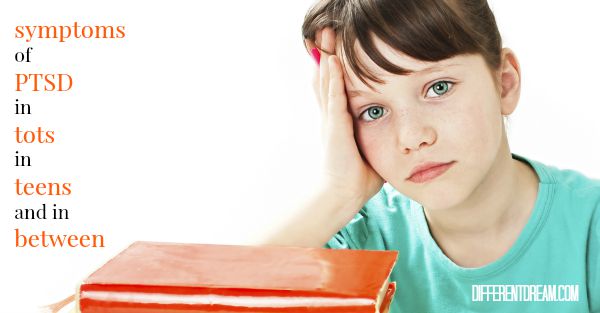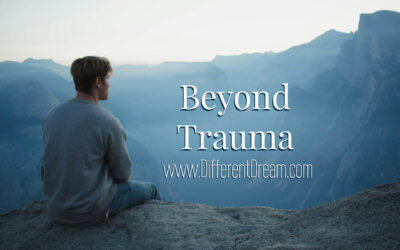Childhood PTSD Symptoms in Tots, Teens, and In Between

Thank you for stopping by to check out the seventh installment in this weekly series about childhood PTSD. In this post, we’ll be looking at symptoms of PTSD in children from infancy through age 18. As you read, keep in mind that these symptoms are commonly seen in children shortly after a traumatic event. For most children, symptoms gradually fade as the trauma is processed and laid to rest. Therefore, a diagnosis of childhood PTSD is not made unless symptoms continue at least 3 months after the original trauma.
As you would expect, symptoms of childhood PTSD change as children mature. Behavioral clues and symptoms in a 2-year-old will be different from those of an 8-year-old, and the 8-year-old’s symptoms may be markedly different from those of a 17-year-old. Therefore, most therapists and mental health experts list symptoms of childhood PTSD in 4 age groups: birth to 3, 3 to 6, 7 to 12, and 13 to 18.
3 Categories of Childhood PTSD Symptoms
Furthermore, the Diagnostic and Statistical Manual (DSM-5) which practitioners use to diagnose mental illness, organizes symptoms of PTSD in 3 categories: intrusive, arousal, and avoidant symptoms. Intrusive symptoms occur when something triggers an unwanted memory of a traumatic event. Arousal symptoms occur when something triggers the body to go into a state of high alert, also known as hyperarousal. Avoidant symptoms come after hyperarousal when the body responds naturally by trying to avoid a threat or pain. Now let’s look at how each category of symptoms is manifested by children within the 4 age groups mentioned earlier.
Symptoms of Childhood PTSD from Birth to 3
Many intrusive symptoms for children in this age group concern sleep patterns. Babies and toddlers may have a hard time falling asleep and experience nightmares once they fall asleep. They may respond violently to something that reminds them of the original trigger. For example, a 1-year-old who was bitten by a dog may become irrational at the sight of a dog Traumatized children in this age group often have a tendency to startle easily, a common arousal symptom. Other arousal symptoms could be excessive fussiness, temper tantrums, severe separation anxiety, and digestive problems. Avoidant symptoms may include withdrawing, avoiding people associated with the trauma, extreme sadness, or a lack of any demonstration of emotion.
To read the rest of this post, go to Key Ministry’s blog, Church4EveryChild.
Part 1: Writing About PTSD Was Not on My Bucket List
Part 2: Childhood Trauma by Any Other Name Is Still Traumatic
Part 3: 10 Myths about PTSD in Children
Part 4: What Causes PTSD in Children
Part 5: A Look Inside the Brain’s Response to Childhood Trauma
Part 6: Why the Spotlight Is on PTSD in Children
Part 7: Childhood PTSD Symptoms in Tots, Teens, and In Between
Part 8: Why and How Childhood PTSD Is often Misdiagnosed
Part 9: Effective Treatment of PTSD in Children
Part 10: How to Prevent PTSD in Traumatized Children
Part 11: How Parents Can Advocate Effectively for Traumatized Children
Part 12: 4 Reasons Traumatized Kids Need Mentally Healthy Parents
Part 13: Clinging to Faith While Parenting Children with PTSD
Do you like what you see at DifferentDream.com? You can receive more great content by subscribing to the quarterly Different Dream newsletter and signing up for the daily RSS feed delivered to your email inbox. You can sign up for the first in the pop up box and the second at the bottom of this page.
By Jolene
Jolene Philo is the author of the Different Dream series for parents of kids with special needs. She speaks at parenting and special needs conferences around the country. She’s also the creator and host of the Different Dream website. Sharing Love Abundantly With Special Needs Families: The 5 Love Languages® for Parents Raising Children with Disabilities, which she co-authored with Dr. Gary Chapman, was released in August of 2019 and is available at local bookstores, their bookstore website, and at Amazon.
1 Comment
Submit a Comment
Subscribe for Updates from Jolene
Related Posts
How Do I Let Go of My Adult EA/TEF Child?
Valeria Conshafter explores the question “How do I let go of my adult EA/TEF child?” for EA/TEF Awareness Month.
The Physical Manifestations of Grief in Caregivers
Jolene explains how the heaviness of loss and sorrow can contribute to the physical manifestations of grief in caregivers.
Experiencing Post-Traumatic Growth while Raising a Child with Disabilities
Jolene explains the benefits of experiencing post-traumatic growth while raising a child with disabilities.






This may explain a few things for us! Thanks for continuing to share at Faith, Hope, and Love!